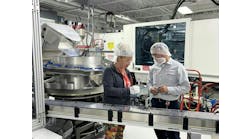3-D Printing on the Factory Floor: Big Promises and Big Challenges
The 2015 IndustryWeek Best Plants conference opened with a bang this morning, featuring a keynote from 3D Systems' Hugh Evans on the amazing future 3-D printed offers the manufacturing world.
After 30 years of development, the vice president of corporate development and ventures told the crowd, 3-D printing is finally ready to come out of the R&D labs and enter real, hardcore manufacturing in a big way.
"It was in the 30th year that the Internet really became mainstream and popular," he said. "It was approximately in the 30th year that the semiconductor industry really went horizontally relevant in many, many sectors.
"In our 30th year, we 're in that same moment."
To prove the point, he highlighted a scattershot of exciting projects happening in plants across the world, including everything from GE Aviation's much touted 3-D printed jet engine fuel nozzle, to the 20 million unique dental features already being churned out by printers at Align Technologies.
"After this 30 years of development, these machines are faster, cheaper, more reliable, more durable and use more materials," he explained. "Now we're finally seeing them enter production."
That transition isn't without disruption, however.
Designing for Function
The move requires what he called a "significant shift in mindset" for engineers and designers accustomed to working under the constraints of traditional subtractive techniques.
"You ask an engineer how many times their designs are compromised by manufacturability, they'll say 100% of the time," he explained. "They always have to do something different for manufacturing constraints or cost constraints."
With 3-D printing, though, those constraints no longer matter. Rather than designing for manufacturability, he said, it's time to start designing for function.
"We have to liberate the engineers and designers," he said. "Design for function. Make the best part possible to perform its function in the best way possible. "
For example, he points to the newly redesigned jet engine brackets announced by GE Aviation.
The design—part of a global innovation challenge issued by the company—transformed the industry-standard bracket blocks into a wild, bird-boned structure nearly impossible to duplicate on traditional machines.
The bracket, conceived by a 20 year old designer from Indonesia, matches the strength of the standard bracket, but reduces the weight by 84%.
That's a revolutionary development, and it's just the beginning.
"We're experiencing a really radical moment in aerospace where they can redesign parts to take weight out," Evans explained. "The industry is in the process of redesigning lots and lots of parts for function."
"When you flip the mentality from design for manufacturability to design for function," he added, "really incredible things can happen."
Manufacturing Constraints
All of this design potential aside, however, Evans noted there are still a couple big manufacturing challenges that production 3-D printers still have to meet: quality assurance and quality control.
"The biggest constraint right now is QA/QC," he explained. "We need to be able to validate that every part that comes out of that printer is repeatable, durable and has the same material specs as the one before it."
While there are many new technologies and advancements aimed at this solving those issues, it remains largely unexplored territory for 3-D printing. And that is a big concern for manufacturers anxious to jump into the field.
"As long as the tool is being used in R&D and the part is meant to be destroyed, we didn't have to worry about QA/QC," he said. "But if I'm making hundreds or thousands of parts and those parts are flying an aircraft, there has to be tremendous QA/QC built around the process.
"That is really the biggest constraint right now: Building in that quality excellence."
Check out our post-keynote chat with Evans to see his vision for meeting these challenges: 3-D Printing: 'Like Having China in Your Garage'





